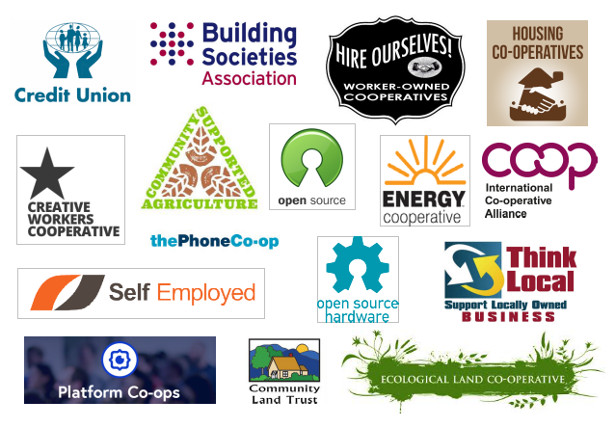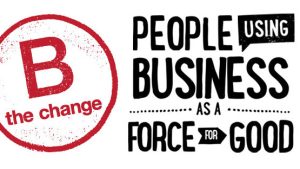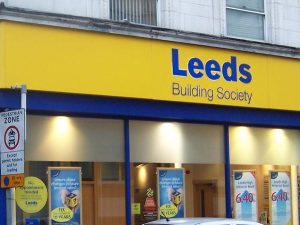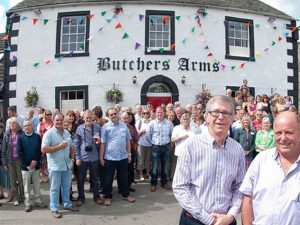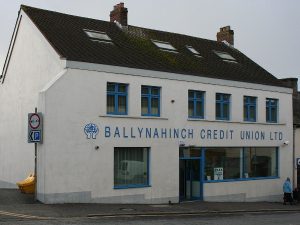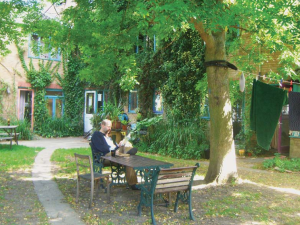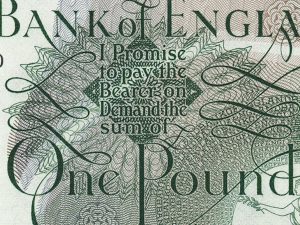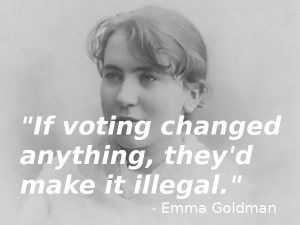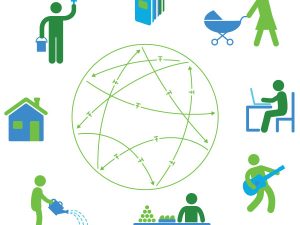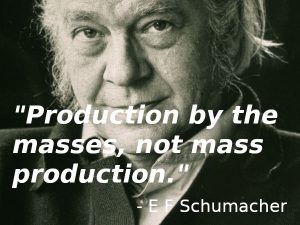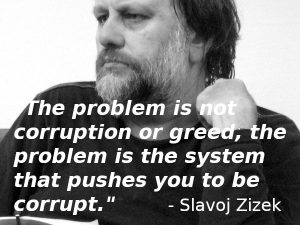This is the first of two articles examining the non-corporate sector, and its advantages for ecology, democracy, communities and individuals. Here’s a checklist of the benefits of reducing the reach of the corporate sector, but first, let’s work out what kind of organisations comprise the non-corporate sector.
It has become difficult to obtain the things we need from non-corporate sources. Most mortgages are with corporate financial institutions, and most people get their food, energy, cars, fuel, holidays, entertainment, banking, software, telephony, clothes and almost everything else from giant multinational corporations. Let’s turn the tide. There are alternatives – capable and committed people are already building a non-corporate sector comprised of the types of organisations outlined below – and we can all help them, by signing up and buying what they produce.
The state sector, although not literally corporate, isn’t included here. It’s a complicated argument, but states are coming more under the sway of the corporate sector all the time – think political donations, the lobby industry, the ‘revolving door’ (corporations giving jobs to politicians and ex-politicians). The state and the corporate sector are now inextricably linked – the state’s role is seen more and more as preparing the ground for the corporate sector to expand. Any state that fails to do this to the best of its ability risks the withdrawal of funds by international investors and the wrath of global financial institutions.
We’re suggesting a sector where the essentials are provided by ordinary people in our communities, with no connection to either the corporate world or the state – and very importantly, with no way for those sources to be taken over by the corporate sector or the state; and indeed, no way for them to become corporations themselves in time. This involves ‘locking in’ a non-corporate structure from the beginning. Supporting the Body Shop, Green &: Blacks or Ben & Jerry’s because they were fresh, funky and delivering a message of democracy, equity and sustainability seems pretty ridiculous now that they’re owned by L’Oreal, Mondelez International and Unilever respectively.
Here’s a list of various structures that comprise the non-corporate sector.
Co-operatives
Co-ops are businesses / organisations that are owned and controlled by their members. They can be comprised of just the members, or involve other stakeholders such as customers or supporters. They are non-hierarchical, democratic institutions. The ‘Co-op’ is a giant co-operative organisation, but the Co-op Bank is no longer a co-operative, having been bought out by a hedge fund after the crash of 2008. The co-operative sector includes worker co-ops, housing co-ops, retail co-ops, land co-ops, consumer co-ops, community energy schemes, credit unions, wholefood co-ops, the Phone Co-op, and now platform co-ops are being developed to provide an alternative to the ‘sharing’ economy (think Über), which is nothing of the sort.
Mutual societies
Mutuals are looser organisations than co-operatives, but they are still member-owned, they pool resources and share risks among members and profit isn’t extracted to pay external shareholders. The best-known example of the mutual model is a building society.
Partnerships
A partnership is a business in which two or more individuals share ownership, and make decisions in a non-hierarchical way. Partnerships are unincorporated (unlike co-ops and mutuals), which means that liability lies with the individuals involved – the partnership itself has no separate identity. There is a legally-binding partnership agreement in which details of how the business will operate and how monies will be shared. There are no external shareholders. GPs often form partnerships.
Employee-owned businesses
Employee ownership can involve co-operative, mutual or partnership structure, or it may just mean that the company was set up (or bought out by employees) with all shares held only by employees, not externally. The John Lewis Partnership, which includes Waitrose, is the largest employee-owned company in the UK. The board is elected and there are no external shareholders.
‘Community-supported’ schemes
Community-supported agriculture (CSA) is the most popular and successful example of this idea. CSA schemes link up small farmers with local consumers who pay up front for produce from the farms. Consumers then know the name of the person who produces their food. In the US, there are also community-supported fisheries, and a handful of projects have started in the UK. Consumers pay up front for weekly deliveries of fish from small fishing boats to local collection points. Although not part of a CSA, direct sales of food by local, small farms and smallholdings to the public include farmers’ markets, farm shops, pick-your-own and veg box schemes.
Trusts
Trusts separate legal ownership from economic interest – i.e. they manage assets but don’t distribute profits. Community land trusts are set up by local people to hold local assets such as housing, community buildings, land for growing food etc., and to keep them affordable.
Social enterprises / not-for-profits
Usually set up to tackle a particular problem or fulfil a particular need in the community, there are various ways that social enterprises can incorporate (including some of the other structures outlined on this page, plus community interest companies, community benefit societies or charities). The key is that there are no external shareholders taking profit from the organisation – any surplus is used for the benefit of the community.
Free / open source
Free software (well, usually software, but it can be other things too) – free as in no cost, but also free to do what you like with, so you can change it and to pass it on to others. Think WordPress, LibreOffice, VLC Media Player, Firefox, Gimp, Linux or even Wikipedia. It’s the opposite of ‘closed source’, or proprietary software such as that produced by Microsoft or Apple.
Blockchain
Blockchain technology is usually thought of as a way of creating cryptocurrencies – money that operates outside the corporate banking system. However, it can be used for many other things – like the Honduran land registry, for example!
Other complementary currencies
Money / exchange systems other than cryptocurrencies are developing that steer trade towards community businesses and individuals and away from the corporate sector, including LETS systems and local / independent currencies.
Social clubs
Unincorporated associations usually set up for mutual benefit / shared interest. Usually governed by a management committee, they don’t distribute profits.
Self-employment
Becoming a sole trader is an easy way to start a business – no incorporation (which means no external shareholders), no requirement to register and file accounts and returns with Companies House, and no need for a constitution. Sole traders can come together – for example in community-supported agriculture schemes that link local people with local small farmers. Sole traders can also form the basis of farmers’ markets and veg box and other food box schemes (but not the bigger ones, some of which are well on the way to corporate status).
DIY
Of course one way to avoid the corporate sector is to provide things for ourselves. This probably isn’t going to involve laptops or TVs (yet – let’s see what 3-D printing will deliver), but it’s very possible to provide our own food, craft or bodycare products, clothes and textiles, or even housing and energy with the right skills.
Downshifting
And finally, an important question is whether we need all the stuff we’re told we need in the first place. Can we do without it, or obtain it by sharing with others?

